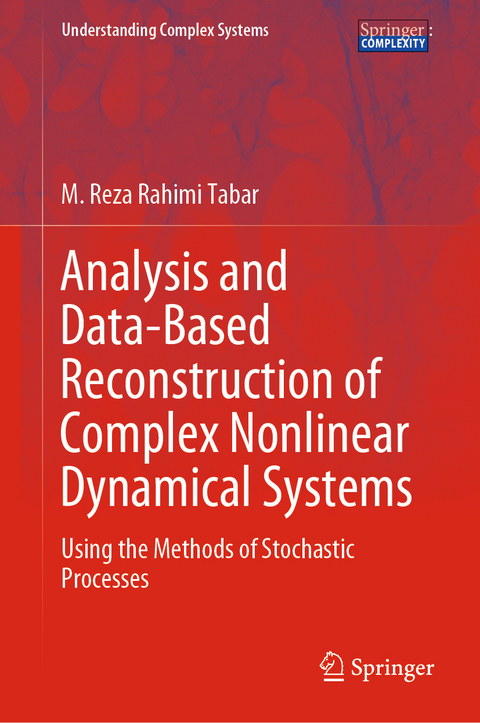
Analysis and Data-Based Reconstruction of Complex Nonlinear Dynamical Systems
Springer International Publishing (Verlag)
978-3-030-18471-1 (ISBN)
This book focuses on a central question in the field of complex systems: Given a fluctuating (in time or space), uni- or multi-variant sequentially measured set of experimental data (even noisy data), how should one analyse non-parametrically the data, assess underlying trends, uncover characteristics of the fluctuations (including diffusion and jump contributions), and construct a stochastic evolution equation?
Here, the term "non-parametrically" exemplifies that all the functions and parameters of the constructed stochastic evolution equation can be determined directly from the measured data.The book provides an overview of methods that have been developed for the analysis of fluctuating time series and of spatially disordered structures. Thanks to its feasibility and simplicity, it has been successfully applied to fluctuating time series and spatially disordered structures of complex systems studied in scientific fields such as physics, astrophysics, meteorology, earth science, engineering, finance, medicine and the neurosciences, and has led to a number of important results.
The book also includes the numerical and analytical approaches to the analyses of complex time series that are most common in the physical and natural sciences. Further, it is self-contained and readily accessible to students, scientists, and researchers who are familiar with traditional methods of mathematics, such as ordinary, and partial differential equations.
The codes for analysing continuous time series are available in an R package developed by the research group Turbulence, Wind energy and Stochastic (TWiSt) at the Carl von Ossietzky University of Oldenburg under the supervision of Prof. Dr. Joachim Peinke. This package makes it possible to extract the (stochastic) evolution equation underlying a set of data or measurements.
Mohammad Reza Rahimi Tabar is Professor in Physics Department of Sharif University of Technology and published over 120 articles in scientific journals. He was fellow of the Alexander von Humboldt Foundation at Oldenburg and Bonn Universities, Mercator guest professor at Osnabru ck University and associate member of ICTP - International Centre for Theoretical Physics.
1 Introduction.- 2 Introduction to Stochastic Processes.- 3 Kramers-Moyal Expansion and Fokker-Planck Equation.- 4 Continuous Stochastic Process.- 5 The Langevin Equation and Wiener Process.- 6 Stochastic Integration, It^o and Stratonovich Calculi.- 7 Equivalence of Langevin and Fokker-Planck Equations.- 8 Examples of Stochastic Calculus.- 9 Langevin Dynamics in Higher Dimensions.- 10 Levy Noise Driven Langevin Equation and its Time Series-Based Reconstruction.- 11 Stochastic Processes with Jumps and Non-Vanishing Higher-Order Kramers-Moyal Coefficients.- 12 Jump-Diffusion Processes.- 13 Two-Dimensional (Bivariate) Jump-Diffusion Processes.- 14 Numerical Solution of Stochastic Differential Equations: Diffusion and Jump-Diffusion Processes.- 15 The Friedrich-Peinke Approach to Reconstruction of Dynamical Equation for Time Series: Complexity in View of Stochastic Processes.- 16 How To Set Up Stochastic Equations For Real-World Processes: Markov-Einstein Time Scale.- 17 Reconstruction of Stochastic Dynamical Equations: Exemplary Stationary Diffusion and Jump-Diffusion Processes.- 18 The Kramers-Moyal Coefficients of Non-Stationary Time series in The Presence of Microstructure (Measurement) Noise.- 19 Influence of Finite Time Step in Estimating of the Kramers-Moyal Coefficients.- 20 Distinguishing Diffusive and Jumpy Behaviors in Real-World Time Series.- 21 Reconstruction of Langevin and Jump-Diffusion Dynamics From Empirical Uni- and Bivariate Time Series.- 22 Applications and Outlook.- 23 Epileptic Brain Dynamics.
| Erscheinungsdatum | 17.07.2019 |
|---|---|
| Reihe/Serie | Understanding Complex Systems |
| Zusatzinfo | XVIII, 280 p. 41 illus., 22 illus. in color. |
| Verlagsort | Cham |
| Sprache | englisch |
| Maße | 155 x 235 mm |
| Gewicht | 572 g |
| Themenwelt | Mathematik / Informatik ► Informatik ► Theorie / Studium |
| Mathematik / Informatik ► Mathematik ► Angewandte Mathematik | |
| Naturwissenschaften ► Physik / Astronomie ► Theoretische Physik | |
| Naturwissenschaften ► Physik / Astronomie ► Thermodynamik | |
| Schlagworte | Complexity • Diffusive Stochastic Behavior • Discontinuous Stochastic Processes • Dynamics of Optically Trapped Particles • From Time Series to Dynamical Equation • Jump-Diffusion Dynamics • Jump-diffusion Processes • Jumpy Stochastic Behavior • Langevin Dynamics • Modeling complex dynamical systems • Modeling epileptic Brain Dynamics • Physics of stochastic processes • Time Series Analysis |
| ISBN-10 | 3-030-18471-4 / 3030184714 |
| ISBN-13 | 978-3-030-18471-1 / 9783030184711 |
| Zustand | Neuware |
| Haben Sie eine Frage zum Produkt? |
aus dem Bereich


